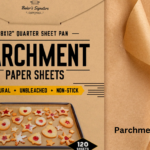Deli paper is a specialized type of food wrapping paper
Deli paper is a specialized type of food wrapping paper used primarily in delis, sandwich shops, and restaurants. It is typically coated on one side, which makes it resistant to moisture and grease, ensuring that it can securely wrap sandwiches, deli meats, cheeses, and other food items without soaking through or compromising the integrity of the food.
The main reasons deli paper is favored in the food industry are its:
- Versatility: It can be used to wrap a variety of food products, from greasy burgers to delicate pastries.
- Aesthetic Appeal: Deli paper often comes with printed designs or can be customized with branding, adding a professional touch to food packaging.
- Convenience: It’s easy to fold and tear, making it a quick solution for food service professionals who need to pack and serve food efficiently.
Wax Paper vs. Deli Paper: What’s the Difference?
Wax paper is another type of food wrapping paper that is widely used in both homes and commercial kitchens. It is coated with a thin layer of wax, usually made from paraffin or soybean, which gives it a non-stick and moisture-resistant surface. Unlike Custom deli paper, wax paper is typically coated on both sides, making it a reliable option for wrapping and preserving food items that contain moisture or grease.
Deli Paper
Deli paper is ideal for fast-paced environments where sandwiches, wraps, and finger foods need to be served quickly and cleanly. Its moisture-resistant properties make it perfect for holding greasy or wet foods without compromising the quality of the packaging. In many cases, it is used as a liner for baskets or trays, giving an added layer of protection and cleanliness.
Wax Paper
Wax paper is highly versatile and useful for wrapping both hot and cold food items. It is commonly used in bakeries for wrapping bread and pastries or in restaurants for separating food items during storage. Its ability to repel moisture also makes it suitable for covering food in refrigerators or freezers to prevent freezer burn.
Butcher Paper
Butcher paper is another type of food wrapping paper that is commonly used for wrapping fresh meats and fish. Unlike deli paper and wax paper, butcher paper is heavier and more durable, making it suitable for packing large cuts of meat. It is also breathable, which is important for maintaining the freshness of raw meats by allowing moisture to escape, preventing spoilage.
There are also other specialty wrapping papers available in the market that cater to specific needs, such as parchment paper, which is ideal for baking, and aluminum foil, which is used for keeping food hot or cold during transport. Each type of food wrapping paper serves a unique purpose in food preservation and presentation.
The Role of Butcher Paper in the Food Industry
Butcher paper is traditionally used by butchers and meat processors to wrap raw meat, poultry, and fish. However, it has found wider applications, particularly in barbecuing, where it is often used to wrap meats like brisket during the smoking process. This allows the meat to retain its moisture while still developing a flavorful crust.
- Strength and Durability: Butcher paper is much thicker and stronger than deli paper or wax paper. It is designed to hold heavy cuts of meat without tearing or breaking.
- Breathability: Unlike wax paper or plastic wraps, butcher paper is breathable, allowing air to circulate around the meat. This is particularly important for raw meats, as it helps to reduce spoilage by allowing excess moisture to escape.
- Uses Beyond Meat Wrapping: Butcher paper is also used for other purposes in the food industry, such as wrapping sandwiches, lining trays, or even as a disposable table covering in seafood restaurants.
Why Choose Deli Paper for Food Packaging?
When it comes to packaging food, especially in a fast-food or takeout environment, deli paper is one of the best choices due to several reasons:
One of the most important features of deli paper is its ability to resist moisture and grease. Whether you’re wrapping a juicy burger or a fresh salad, deli paper prevents grease from leaking through, keeping both the food and packaging clean.
Deli paper offers a unique advantage in that it can be easily customized. Restaurants and delis can print their logos, slogans, or design patterns directly onto the paper. This adds a professional and personal touch to the packaging, helping with brand recognition and customer satisfaction.
Cost-Effective Solution
Compared to other food packaging materials like plastic or aluminum, deli paper is a more affordable option. It can be purchased in large quantities at a low cost, making it the preferred choice for high-volume businesses like delis, food trucks, and fast-food chains.

The Importance of Choosing the Right Wrapping Paper for Your Business
Selecting the right type of food wrapping paper is crucial for any food service business. Not only does it enhance the overall presentation of the food, but it also plays a significant role in preserving freshness, maintaining hygiene, and preventing contamination.
Protection and Preservation
Food wrapping paper acts as a barrier, protecting food from external contaminants such as dust, bacteria, and other harmful elements. It also helps to maintain the freshness of the food by preventing moisture loss and keeping air out, which is essential for perishable items like sandwiches, deli meats, and pastries.
Enhanced Presentation
The appearance of food packaging can influence customer perception. A well-wrapped sandwich in clean, attractive deli paper not only looks professional but also enhances the customer’s dining experience. Custom-printed deli paper adds a layer of sophistication and reinforces brand identity.
Convenience for Customers and Staff
Deli paper is easy to handle and use. For businesses, this means faster service and smoother operations in the kitchen. For customers, it ensures a mess-free and convenient experience when eating on the go. The ability to wrap, tear, and dispose of deli paper quickly makes it a practical option for both parties.
Wax Paper and Its Uses in the Kitchen
While deli paper is excellent for food service and takeout, wax paper finds its strength in kitchen applications. Wax paper is often used for:
- Baking Preparation: Lining baking trays or wrapping dough to prevent sticking.
- Storage: Keeping baked goods, cheese, or cold cuts fresh in the refrigerator.
- Separation: Preventing food items like patties or cookies from sticking together during storage.
Wax paper’s moisture-resistant properties also make it useful for wrapping food for short-term storage, particularly in cases where refrigeration is involved.
Conclusion
In the food service industry, choosing the right type of wrapping paper—be it deli paper, wax paper, or butcher paper—can make all the difference in the presentation and preservation of food. Deli paper stands out as a versatile, cost-effective, and visually appealing solution for businesses looking to package food quickly and efficiently.
Understanding the unique benefits of each type of food wrapping paper will help businesses not only maintain food quality but also enhance the customer experience through thoughtful packaging. Whether it’s for sandwiches, meats, or bakery items, finding the right balance between functionality, hygiene, and presentation is key to a successful food service operation.
Each of these wrapping papers plays a unique role in the culinary world, and choosing the right one for your needs ensures the best possible result for both your business and your customers.







